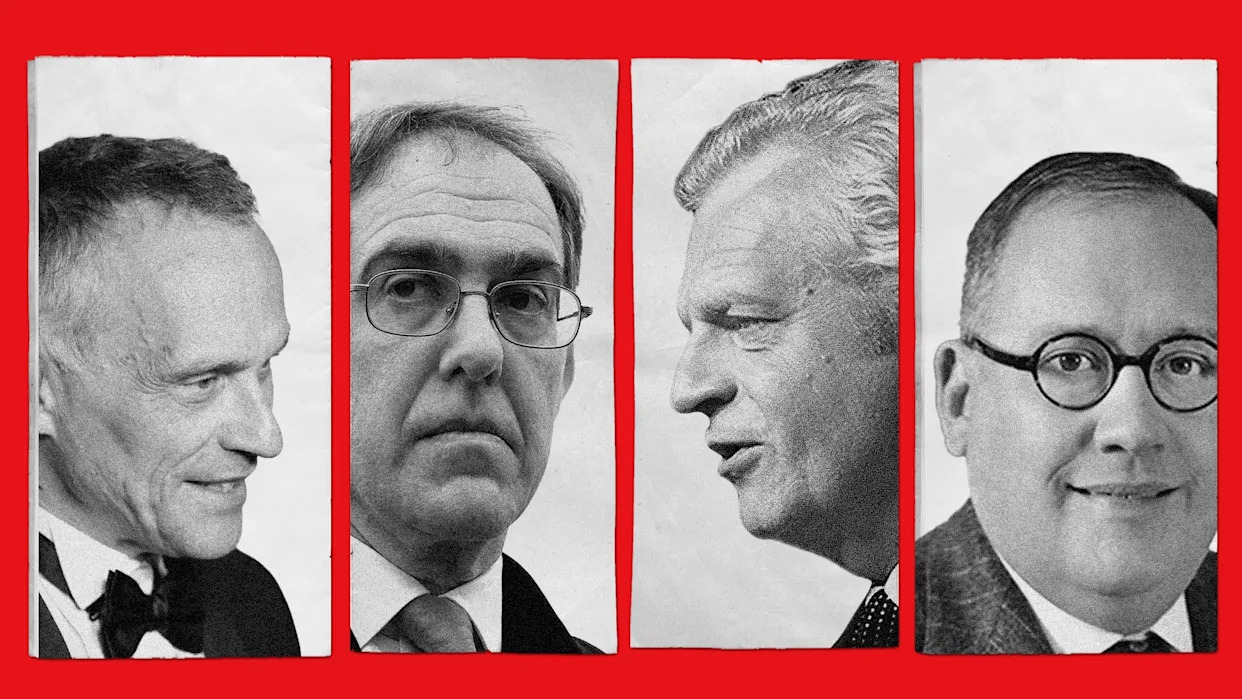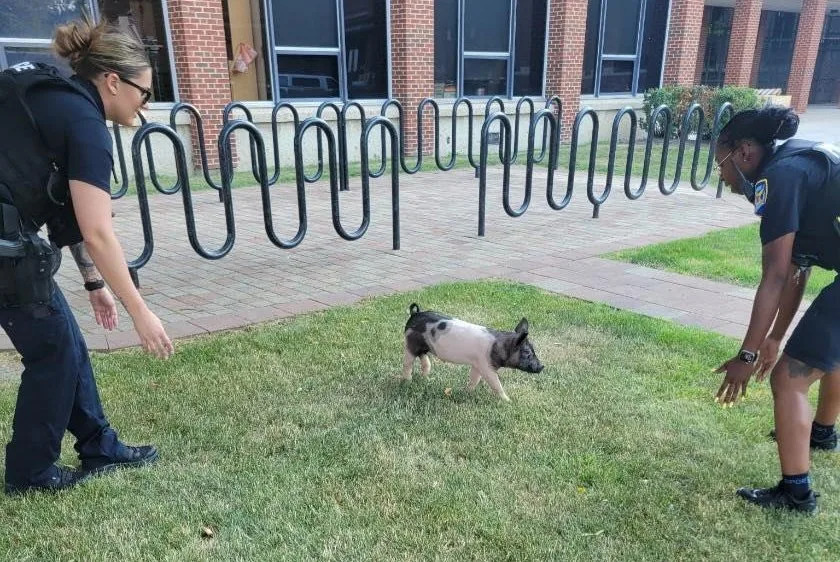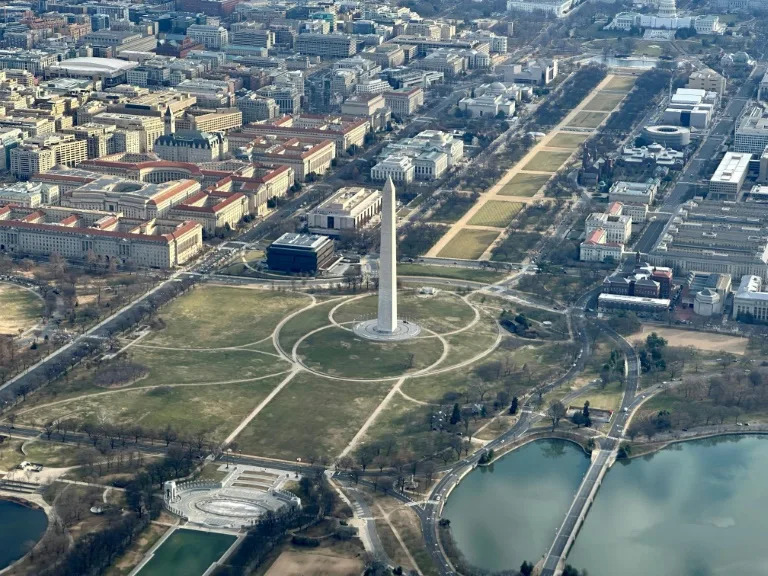
The Atlantic Daily, a newsletter that guides you through the biggest stories of the day, helps you discover new ideas, and recommends the best in culture. Sign up for it here.
The leaders of America’s elite universities are required, by the borderline-masochistic, semi-impossible nature of their job, to be skilled in the art of performative comity. So it was a bit of a shock when, at the end of an April panel discussion, Princeton President Christopher Eisgruber turned on the chancellors of Vanderbilt and Washington University in St. Louis, all but accusing them of carrying water for the Trump administration.
Eisgruber argued that higher education was facing a politically motivated attack, and that the two men were inadvertently making matters worse by agreeing with President Donald Trump, against the evidence, that the sector had grown illiberal and out of touch with mainstream America. The chancellors, taken aback by the public confrontation, countered that the struggles of a handful of Ivy League schools were dragging down the reputation of America’s heavyweight research institutions. Perhaps, they suggested, it was time for the Ivies’ leaders to step back and let new figures—such as themselves—represent the country’s top universities.
The argument, which took place at a Washington, D.C., meeting of the Association of American Universities, which Eisgruber chairs, went on for about 15 minutes, according to multiple people in attendance. The tone was civil, but awkward. The three public-university presidents unlucky enough to also be on the panel sat in bewildered silence. Meanwhile, many in the audience of assembled presidents shifted in their chairs and stared at their phones. When time finally ran out, some thanked a higher power.
The stated topic that day was the public’s decreasing trust in higher education. Inevitably, the conversation turned to “institutional neutrality,” the idea that universities, in order to protect their reputation for unbiased scholarship, should not take positions on matters unrelated to higher education. Some schools, most notably the University of Chicago, have embraced neutrality for generations. Others have become newly enamored of the idea, for two reasons: University presidents—at least those with even the slightest instinct for self-preservation—do not want their schools weighing in on matters related to war in the Middle East. And they understand that the Trump administration, which, by the evidence, seems to loathe elite higher education generally and the Ivy League specifically, is on the hunt for proof that these schools are irretrievably “woke,” diversity-obsessed, anti-Republican, and anti-Semitic.
Trump’s preoccupation with the Ivy League has been expensive for at least two of its members. Columbia recently agreed to pay more than $200 million to get the government off its back. Harvard is still fighting the Trump administration in court, and is at risk of losing $1 billion over the next year. Princeton has largely escaped the president’s wrath, even though Eisgruber has become a leader of what you might call the academic resistance: a group of university leaders who believe that Trump’s criticisms of the sector are a pretext for eliminating academic freedom. And, in part because Eisgruber is one of the longest-serving Ivy League presidents and has a supportive board behind him, he has become vocally, if diplomatically, critical of other university presidents who he believes go too far to meet Trump’s demands.
Those other university officials—led by Washington University’s Andrew Martin and Vanderbilt’s Daniel Diermeier, the chancellors who sparred with Eisgruber on the panel—make up the reformist camp. They accept some of Trump’s complaints and believe that the best path forward for higher education is to publicly commit to a kind of voluntary, modified de-wokeification. They argue that some campuses (in, say, Cambridge and Morningside Heights) and departments (much of the humanities) have leaned too far into leftist ideology and allowed anti-Semitism to fester under the guise of protesting Israeli policies. They want the American public to know that they are different from the Ivies. And they think that higher education needs new representation if it’s going to regain the country’s trust.
[Ian Bogost: A new kind of crisis for American universities]
Both factions insist that they respect the other side and are merely acting in the best interest of their institutions. But the question of who will lead higher education into the future is necessarily personal. Eisgruber’s position as AAU chair and Princeton’s stature among American universities make him a natural spokesperson. But many higher-ed leaders suspect that Martin and Diermeier are trying to topple the Ivies. “Among the establishment—the celebrity institutions and the association heads—there is a sense that Vanderbilt and Wash U have been trying to break out of the muddy middle of reasonably sized research institutions, and they see this as an opportunistic moment to take ground from all the people who have snubbed them in the past,” Ted Mitchell, the president of the American Council on Education, the largest higher-education trade group, told me. (Diermeier said he spoke up because he felt that it was important for people to hear his message; the boon to Vanderbilt’s public profile was incidental. Martin said it’s his job to advocate for his institution.)
These arguments are happening mainly behind closed doors, but the level of privately expressed annoyance is high. I’ve heard of presidents labeling one another cowardly, naive, delusional, and irrelevant. The threat posed by out-of-control protesters on the left and by the Trump administration on the right could have united these institutions. Instead, these threats have left them frustrated, embittered, and paralyzed by disagreement.
The reformists believed that higher education had a problem even before Trump was reelected. They watched as conservative speakers were shouted down or disinvited from campuses. They saw professional organizations publicly commit themselves to positions that sounded more like activism than scholarship. (The academics who make up the American Anthropological Association, to cite one example, announced in 2020 that their “research, scholarship, and practice” should be placed “in service of dismantling institutions of colonization and helping to redress histories of oppression and exploitation.”) After the Hamas invasion of southern Israel on October 7, 2023, the reformists watched as anti-Israel protesters on other campuses occupied buildings, erected encampments, and, in some cases, engaged in overt anti-Semitism. “You can’t look at what happened on many university campuses last academic year and conclude that everything is just fine,” Martin told me.
Early last year, Martin and Diermeier began working on a Statement of Principles for higher education. “If research universities are to pursue the truth wherever it lies, they cannot have a political ideology or pursue a particular vision of social change,” they wrote. Their university boards adopted the principles as official policy in the fall of 2024, before the presidential election. “Our view was, we have to proactively work on the reform of education, which meant most importantly to be firmly committed to knowledge creation and transmission,” Diermeier, who previously served as provost of the University of Chicago, told me.
Trump’s second term gave the chancellors reason to push for the reforms they believed were long overdue. They urged other university leaders to adopt the principles and argued that higher education must show that it is receptive to conservative concerns. Vocal resistance would be naive, they warned—and futile. “It’s not about fighting. It’s about winning,” Diermeier told me. “We need to have the twin messages of reaffirming the greatness of American research with a commitment to reforming.”
In late March, Martin and Diermeier assembled several dozen like-minded college presidents, board chairs, and think-tank leaders in Dallas to launch a coalition of institutions that are focused on reform. They’ve held conversations with more than 20 colleges, among them Dartmouth—the lone Ivy League member of the reformist camp—and Rice University. Now they’re trying to get presidents to commit to the principles they’ve put forward and join the invite-only group, called Universities for America’s Future. The chancellors say that they started the organization because existing trade groups were divided over whether to reform, making it impossible to consider specific changes. But the splinter group is broadly viewed as an effort to supplant the AAU. Its argument has begun to catch on more widely. Many top schools have pledged to stay neutral on issues that don’t affect their academic mission, rather than issue predictably progressive statements on the political controversy du jour. And this spring, when students at Yale began building a tent encampment and students at Columbia occupied part of a library building, the universities took a hard-line approach. Yale quickly disciplined students, and Columbia called in the police. (Both earned praise from the Trump administration for their response.)
On the other side is Eisgruber, who declined to be interviewed for this article. Although he does not criticize Trump directly, he has urged presidents to stand up for universities’ legal rights and speak out against the government’s attacks on higher education, rather than cede even more ground to its detractors by making a big show of self-criticism. After the administration yanked $400 million in funding from Columbia, much of it for biomedical research—and demanded that the university make a number of concessions to get the money back—Eisgruber published an essay in this magazine defending higher education’s record. “The United States is home to the best collection of research universities in the world,” he wrote. “Those universities have contributed tremendously to America’s prosperity, health, and security.”
[Christopher L. Eisgruber: The cost of the government’s attack on Columbia]
In subsequent interviews, Eisgruber argued that American higher education was in better shape than ever before. He rejected the right-wing narrative that universities indoctrinate students in leftist ideology, as well as the notion that they should attempt to achieve an ideological balance that matches the country’s. And although he acknowledged that disturbing and “unacceptable” instances of anti-Semitism had taken place on campuses, he pushed back on the idea that it’s a pervasive problem that universities aren’t addressing. Princeton’s Jewish students, for example, report the highest feelings of belonging on campus, Eisgruber said.
Michael Roth, the president of Wesleyan University, in Connecticut, has also emerged as an important resistance figure. Although Wesleyan is not as large as many of the other institutions engaged in this argument (and is generally seen as even more left-leaning than Columbia and Harvard), Roth is, by the standards of university presidents today, unusually sharp-elbowed and bellicose. He takes a withering view of “institutional neutrality,” which he sees as a form of cowardice. Accordingly, he has taken public positions on issues as varied as the kidnapping of schoolgirls in Nigeria, transgender rights, and the war in Ukraine. “It’s really important for people who have the ability to speak out against this overreach by the government to do so,” he told me. “The policy at Wesleyan is that our president shouldn’t say stupid shit.” Otherwise, let it rip.
Roth was gratified when, in April, the American Association of Colleges and Universities, a higher-education trade group, published an open letter that he had pushed for and that called out the “unprecedented government overreach and political interference now endangering American higher education.” Nearly 700 college presidents have signed on—though, notably, not Martin and Diermeier.
The resistance camp has accused the reformers of scapegoating their fellow universities in order to win favor with Trump. They point to the fact that Vanderbilt hired a lobbyist who has ties to the president’s circle. “It’s just so they can ingratiate themselves with the executive branch right now,” Roth told me. “I think it’s shameful.” (Several Ivy League leaders have also tapped lobbyists and lawyers with Trump connections to represent their institutions.)
Many elite-university presidents find themselves somewhere between the two extremes. Harvard, for example, enjoyed a round of adulation from liberal America when it sued the Trump administration for pulling its funding without an investigation. But it has also given in to a number of the government’s demands. It dismissed the faculty leaders of its Center for Middle Eastern Studies, which had been criticized for programming alleged to be anti-Semitic, and replaced its diversity office with one ostensibly focused on community building. It is now considering a financial settlement with the Trump administration.
Some college presidents just wish the fighting would stop. One said that Martin and Diermeier, on the one side, and Roth and Eisgruber, on the other, seem to be thumping their chests and competing for their peers’ attention. Debates among them derail meetings and waste time, that president (who spoke anonymously to divulge details of private discussions) told me. When Wesleyan battles against Washington University, or Vanderbilt against Princeton, other attendees around the table surreptitiously roll their eyes. Most presidents I spoke with believe that, despite their posturing, the leaders of the resistance and reform groups are more aligned than they think. “They’re both right,” Mitchell, the American Council on Education president, told me. “The challenge is how we can push for change while at the same time defending the absolute critical importance of higher education to America.”
Even so, the divide has had real effects. One particular sticking point was how to resist Republican efforts to raise taxes on universities’ endowment-investment income. Congress first imposed a 1.4 percent tax on the net investment income from the largest endowments in 2017, during Trump’s first term. This year, representatives considered proposals for a tax rate as high as 21 percent. Harvard’s president, Alan Garber, once called the endowment tax the “threat that keeps me up at night.”
[Franklin Foer: Can Alan Garber save Harvard?]
Eisgruber helped assemble about two dozen of the richest universities to lobby against the tax. They proposed that schools spend more of their endowment income, and spend it specifically on financial aid, as well as teaching, in exchange for being spared the higher tax rate. But the group made no mention of other reforms. Republican representatives, meanwhile, had been telling university presidents that they wouldn’t give them a tax break to go on indoctrinating students. Vanderbilt and Washington University therefore decided to lobby separately rather than be associated with a group that wouldn’t accept blame for higher ed’s problems. They pushed for new tax credits for universities that use their endowments to improve student access, instead of arguing against the tax itself. In the end, Congress included an 8 percent tax on the richest universities in its One Big Beautiful Bill Act. Whether that figure would have been lower had the universities found a way to put up a united front is impossible to say. But the infighting probably didn’t help.
The divide between the reformer and resistance camps is not merely about strategy; it’s about the nature of the threat to higher education. Members of the resistance group conceive of Trump as a unique—and ultimately passing—problem: If they can survive his presidency, they’ll be safe. This seems to have led them to resist making deep, lasting changes. At Princeton, Eisgruber has earned praise for maintaining the university’s DEI initiatives while other schools scrub their websites. He has retained the university’s policy of divesting its endowment from some fossil-fuel companies. And he has defended his policy of institutional restraint, rather than neutrality, saying that the university can’t avoid taking a stand on some issues.
Roth told me that universities have room to improve on some fronts, including increasing viewpoint diversity among faculty. But he believes that they can address that on their own time once Trump is out of office. “To be worried about that right now seems to me like people in Ukraine worrying about corruption in the mining industry,” Roth told me. “It’s the Russians that are the problem.”
The reformers think the resistance presidents are delusional for believing that their problems will go away when Trump does. They see the president’s attacks as symptomatic of a larger issue. Polling shows that confidence in American higher education has cratered in recent years, especially among Republicans. “The fundamental fact here is that we have never been in worse shape in my lifetime,” Diermeier told me. The reformer presidents, who tend to be in red or purple states, think the resistance leaders are trapped in liberal echo chambers. “It’s clear that the bipartisan support has eroded,” Martin told me. “It’s really misguided to think that what’s happening in higher education is a blip and that we’re going to return to where we were before.”
He and his allies believe that universities should have started cleaning up their act years ago. Now they’re playing catch-up, and can’t expect to stop just because Trump will someday leave office. “Once you’ve been portrayed as the villain, that creates a job description for the hero,” Diermeier told me. “Many people want that job.” He was speaking about politicians attacking universities to raise their own profile. But I got the sense that it characterized higher-education leaders’ thinking too.
*Photo-illustration by The Atlantic. Sources: Efren Landaos / Sipa USA / Reuters; Reynolds Stefani / CNP / ABACA / Reuters; USA Today Network / Reuters; James Byard / Washington University (CC-BY-SA-4.0).








Comments